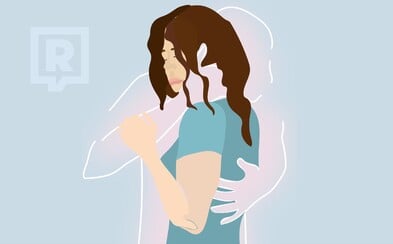 Filip visited the abandoned Soviet Baikonur Cosmodrome: The sight of the ruins of the most expensive space project is unreal
Filip visited the abandoned Soviet Baikonur Cosmodrome: The sight of the ruins of the most expensive space project is unreal
Filip visited the abandoned Soviet Baikonur Cosmodrome: The sight of the ruins of the most expensive space project is unreal
Filip visited the abandoned Soviet Baikonur Cosmodrome: The sight of the ruins of the most expensive space project is unreal
Children Are "Digitally Born" At Around Six Months. However, Excessive Sharing Of Their Photos Is Rather Harmful
Hey, look, here's our baby sitting naked on the potty! Posts like these are classics in the age of digital parenting.
If problems persis, please contact administrator.
Sharenting. This refers to the activity of parents who resort to excessive sharing of information, photos and videos of their children on social networks - often without their consent. For example, according to the UK Children's Commissioner's Office, parents of children under the age of 13 post an average of 71 photos and 29 videos of their child on social media each year. But what is the price of sharing "funny" and "cute" photos on the Internet?
While parents may not see a problem with posting their kids, older kids get frustrated. For example, in a 2016 study, many children expressed concern that their parents were excessively posting content on social media without their consent. Children reported that adults should recognize their autonomy and if they do not want to be exposed online, parents should respect this. This is related, according to the research team, to the fact that teenagers usually agree on sharing with each other. For example, that they will not tag each other in photos or that they will only do so with express consent. In short, research suggests that children and adolescents have a need to be in control of their online image. Sharenting undermines this.
Parents create an Internet identity for their offspring that their children don't care about - and often don't agree with. Sharenting can lead to the identification of a child's place of residence or school, reveal what the child looks like, when their birthday is, and what they like and dislike. The disclosure of identification data may subsequently expose the child to the risk of so-called "digital kidnapping". For example, according to research by Barclays, by 2030, information shared by parents online will account for two-thirds of identity theft among young people. But the scenarios can also be less catastrophic - sensitive information can also be collected by companies for marketing purposes.
Babies are "born digitally" at about six months
Sharenting can start in the womb, when expectant parents upload images from an ultrasound examination or publish the due date. Some parents - this is especially typical for well-known personalities and celebrities - create a social media account for their child even before birth. For example, a study by security company AVG found that 92% of American children have some kind of online footprint by the age of two. Around the world, on average, babies are "born digital" at around six months, with a third having their photos posted on the internet within two weeks of birth. This can lead to emotional damage in the child's later years - especially when the parent resorts to so-called "internet shaming", i.e. sharing visual material that the child marks as embarrassing or mocking.
According to experts in media communication, parenting or "mom" blogs, YouTube channels and other channels that are based exclusively on children are particularly problematic. Of course, the rule also applies here - what is once on the Internet, is on the Internet forever. As the author team of The Routledge International Handbook of Young Children's Rights points out, the children of these influencers are growing up in front of everyone. At the same time, children from 'YouTube families' who appear in roles may be at risk of being pressured or manipulated by their parents to secure loyal fans and financial gain. Such behavior is also common among so-called "micro-celebrities", whose children are particularly vulnerable. “When 'microcelebrities' post pictures, videos or information about their child on social media, they may be doing so for their own selfish interests; they want to make money or use their children to increase their celebrity status or increase their number of followers,” the authors state.
The phenomenon is present on social networks to an ever greater extent, which, of course, increases the danger associated with it in direct proportion. And this despite the fact that in most cases parents share their children with the best of intentions: to preserve the memory, keep in touch with the family and show off to those closest to them.
What can be hidden behind the "innocent" sharing of cute photos was summarized for Refresher by Kamil Kopecký, head of the Center for the Prevention of Risky Virtual Communication at the Faculty of Education of the Palacký University in Olomouc and head of the E-Safety project.
What should we consider before posting a photo of our child on a social network?First of all, you really need to ask yourself whether it is necessary to upload and publish hundreds of photos of our child on the Internet. It's good to be aware that photos spread very easily on the internet and what we share publicly (as well as privately) can easily get out of our control. It is also a good idea to consider whether it would agree with uploading a photo or video to the Internet. In the case of older children, it is natural and fair to ask for their consent.
What principles should a parent follow when they decide to share their child on the Internet?It is natural that parents want to brag about their child in the online environment and share their experiences with other users, for example from vacations, trips, etc. But at the same time, at least minimum safety principles must be observed. As parents, we should definitely consider whether a photo or video that we upload to the Internet (especially social networks) could harm our child in some way - whether in the present or in the future, several years from now.
As parents, let's consider whether it is really necessary to share with millions of people a photo of our child, for example, on the potty, a child sleepy from food, a child who is constantly crying. Parents may find these photos cute, but a child who is gradually growing up finds them humiliating.
In no case should we share photos or videos in which the child is naked - such photos do not belong on the Internet. Social networks also should not include so-called prenatal profiles, i.e. profiles of unborn children that their parents set up for them. An ultrasound photo is usually used as a profile photo. Of course, other sensitive information about the child, such as details about the child's health or birth number, does not belong on social networks.
In your opinion, should this sharing be regulated in some way? After all, a child can only set up an account on social networks at the age of 13In connection with the changes in the GDPR system, individual European countries have chosen age limits from which children can independently - without parental consent - set up accounts on social networks. However, age limits does not solve anything at all, social networks are commonly used by children under the age of thirteen, and they can easily bypass the age regulation by changing their date of birth.
In this case, we are talking about situations where children's materials are shared by an adult, a parent. And the rules of social networks do not prohibit sharing photos of children (if it is not strictly pornographic content). Moreover, parents do not share these materials purely in the social network environment, various photo galleries or various types of blogs and thematic pages are also very popular.
For me, the most important thing is the education and systematic education of parents, who must realize that by sharing these materials excessively, they can harm their child.
Is sharenting a new phenomenon?Sharenting appeared at a time when it was very easy to take a digital photo and distribute it over the Internet to a large number of people. Its beginnings can be found somewhere between 2004 and 2007, when mobile phones appeared that made it easy and fast to take photos and videos, and at the same time there were platforms where this content could be shared with others, such as Facebook. Of course, even in the past, people liked to show off photos of their offspring - but without the Internet, they couldn't mass-distribute them, and photos couldn't be copied so easily. It is therefore a phenomenon associated primarily with the present.
Can this trend influence the formation of a child's (online) identity?Definitely yes. Let's imagine a situation where a teenager begins to actively use social networks and wants to create his own digital virtual identity here. He wants to choose himself what photos and videos he will share on the Internet, what he will write, what content he will watch, who he will add as friends. And suddenly he discovers that the Internet is full of photos of him from his childhood, which his parents uploaded to the Internet, and many photos are downright embarrassing for him - such as the already mentioned potty, photos with a bib, or photos of a naked child, for example, from vacation.
The problem is, of course, that classmates and other peers of the child get access to these photos, who can then easily abuse them, for example for cyberbullying.
Many children try to get their parents to remove these photos of them from the Internet, but the parent does not always accept the child's request. Abroad, there are many cases where a child even sues his parent over the deletion of photos or videos that the parents have uploaded to the Internet. It is necessary to realize that the child has the right to decide what his digital traces will look like on the Internet.
Have you ever experienced a serious impact sharenting?At the E-Safety in the field educational events, we are regularly approached by 2nd grade elementary school students who have this problem and try to convince their parents (often in vain) to delete their photos from the networks. We also dealt with situations where classmates discovered photos of their classmate that were shared on Facebook by his parents. The child victim was given an unflattering nickname based on the content of the shared photo.
At the E-Safety consultancy, we have also dealt with situations where parents complained that someone had shared published photos of their children on various types of specialized sites (e.g. for the pedophile community), where users commented inappropriately on them.
It is also very interesting to see how many photos of children are visited, which are shared, for example, through public photo galleries. Photo galleries in which children are partially or completely naked (typically photos from bathing, swimming, but in recent years also, for example, photos from christenings) have significantly more visitors than photo galleries where children are clothed (e.g. from a trip). It is a question of who are the visitors of these photo galleries.
If problems persis, please contact administrator.












